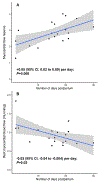Coronary Microvascular Function Following Severe Preeclampsia
- PMID: 38563161
- PMCID: PMC11096023
- DOI: 10.1161/HYPERTENSIONAHA.124.22905
Coronary Microvascular Function Following Severe Preeclampsia
Abstract
Background: Preeclampsia is a pregnancy-specific hypertensive disorder associated with an imbalance in circulating proangiogenic and antiangiogenic proteins. Preclinical evidence implicates microvascular dysfunction as a potential mediator of preeclampsia-associated cardiovascular risk.
Methods: Women with singleton pregnancies complicated by severe antepartum-onset preeclampsia and a comparator group with normotensive deliveries underwent cardiac positron emission tomography within 4 weeks of delivery. A control group of premenopausal, nonpostpartum women was also included. Myocardial flow reserve, myocardial blood flow, and coronary vascular resistance were compared across groups. sFlt-1 (soluble fms-like tyrosine kinase receptor-1) and PlGF (placental growth factor) were measured at imaging.
Results: The primary cohort included 19 women with severe preeclampsia (imaged at a mean of 15.3 days postpartum), 5 with normotensive pregnancy (mean, 14.4 days postpartum), and 13 nonpostpartum female controls. Preeclampsia was associated with lower myocardial flow reserve (β, -0.67 [95% CI, -1.21 to -0.13]; P=0.016), lower stress myocardial blood flow (β, -0.68 [95% CI, -1.07 to -0.29] mL/min per g; P=0.001), and higher stress coronary vascular resistance (β, +12.4 [95% CI, 6.0 to 18.7] mm Hg/mL per min/g; P=0.001) versus nonpostpartum controls. Myocardial flow reserve and coronary vascular resistance after normotensive pregnancy were intermediate between preeclamptic and nonpostpartum groups. Following preeclampsia, myocardial flow reserve was positively associated with time following delivery (P=0.008). The sFlt-1/PlGF ratio strongly correlated with rest myocardial blood flow (r=0.71; P<0.001), independent of hemodynamics.
Conclusions: In this exploratory cross-sectional study, we observed reduced coronary microvascular function in the early postpartum period following preeclampsia, suggesting that systemic microvascular dysfunction in preeclampsia involves coronary microcirculation. Further research is needed to establish interventions to mitigate the risk of preeclampsia-associated cardiovascular disease.
Keywords: blood pressure; cardiovascular diseases; heart failure; preeclampsia; pregnancy.
Conflict of interest statement
Figures



Update of
-
Coronary Microvascular Function Following Severe Preeclampsia.medRxiv [Preprint]. 2024 Mar 5:2024.03.04.24303728. doi: 10.1101/2024.03.04.24303728. medRxiv. 2024. Update in: Hypertension. 2024 Jun;81(6):1272-1284. doi: 10.1161/HYPERTENSIONAHA.124.22905. PMID: 38496439 Free PMC article. Updated. Preprint.
References
MeSH terms
Grants and funding
- T32 HL094301/HL/NHLBI NIH HHS/United States
- R01 HL170058/HL/NHLBI NIH HHS/United States
- K08 HL166687/HL/NHLBI NIH HHS/United States
- K23 HL159276/HL/NHLBI NIH HHS/United States
- R01 HL148565/HL/NHLBI NIH HHS/United States
- R01 HL142711/HL/NHLBI NIH HHS/United States
- R01 HL160003/HL/NHLBI NIH HHS/United States
- R01 HL148050/HL/NHLBI NIH HHS/United States
- R01 HL162960/HL/NHLBI NIH HHS/United States
- R01 EB034586/EB/NIBIB NIH HHS/United States
- R01 HL168889/HL/NHLBI NIH HHS/United States
- K23 HL159243/HL/NHLBI NIH HHS/United States
- K24 HL153669/HL/NHLBI NIH HHS/United States
- K23 HL159279/HL/NHLBI NIH HHS/United States
LinkOut - more resources
Full Text Sources
Miscellaneous

